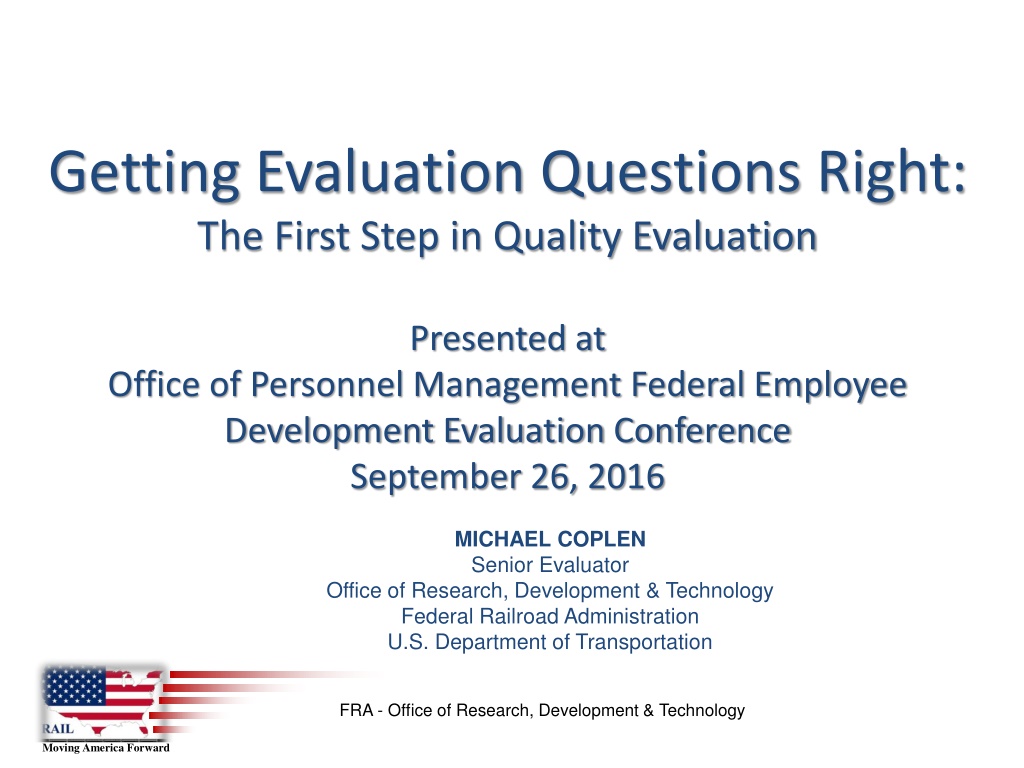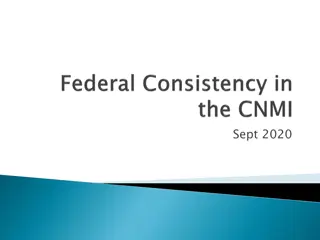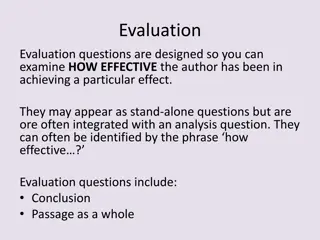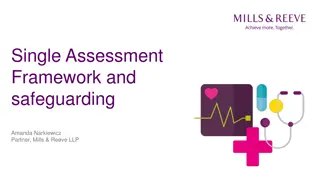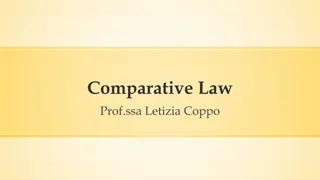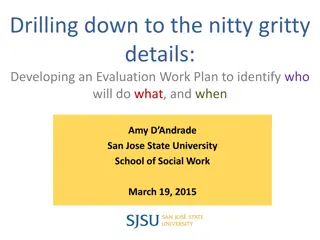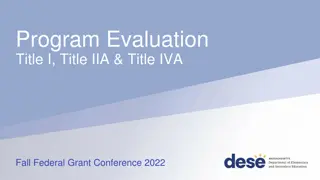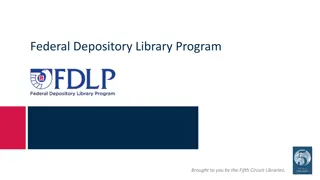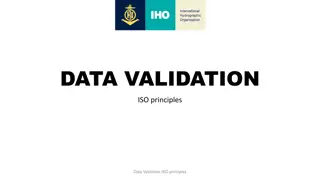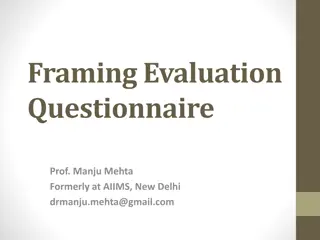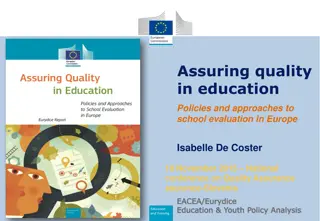Understanding Evaluation Questions for Quality Assessment in Federal Programs
Presentation by Michael Coplen at the Office of Personnel Management Federal Employee Development Evaluation Conference focused on the importance of developing quality evaluation questions, common flaws, and driving actionable evaluation by using evidence and rigorous criteria. The session highlighted the significance of evaluation in federal programs based on mandates and initiatives, emphasizing the need for effective program assessments and decision-making based on empirical data.
Download Presentation

Please find below an Image/Link to download the presentation.
The content on the website is provided AS IS for your information and personal use only. It may not be sold, licensed, or shared on other websites without obtaining consent from the author. Download presentation by click this link. If you encounter any issues during the download, it is possible that the publisher has removed the file from their server.
E N D
Presentation Transcript
Getting Evaluation Questions Right: The First Step in Quality Evaluation Presented at Office of Personnel Management Federal Employee Development Evaluation Conference September 26, 2016 MICHAEL COPLEN Senior Evaluator Office of Research, Development & Technology Federal Railroad Administration U.S. Department of Transportation FRA - Office of Research, Development & Technology Moving America Forward
DISCLOSURE The views and perspectives in this presentation are solely those of my own, and do not purport to represent those of the Federal Railroad Administration, the Department of Transportation, or the federal government. FRA - Office of Research, Development & Technology 2 Moving America Forward
Overview Evaluation context: history, definition, roles, evaluation frameworks. What are some common flaws in developing evaluation questions? What constitutes good quality evaluation questions? What? So what? Now What? Exemplar program with illustrative questions How do quality evaluation questions drive useful, actionable evaluation? FRA - Office of Research, Development & Technology Moving America Forward
What is evaluation? Evaluation is the systematic application of defensible criteria to determine the value, merit or worth (i.e. quality, utility, effectiveness, or significance) of something. Program evaluations answer big picture questions about programs, like: How well was the program designed? To what extent did the program achieve its goals? Are the results worth what the program costs? Should it continue? How can it be improved? FRA - Office of Research, Development & Technology 4 Moving America Forward
Why Evaluation in Federal Programs? Congressional Mandates Government Performance and Results Act (GPRA, 1993) Program Assessment Rating Tool (PARTs, 2002) GPRA Modernization Act of 2010 OMB Memos M-13-17, July 26, 2013: Next Steps in the Evidence and Innovation Agenda M-13-16, July 26, 2013: Science and Technology Priorities for the FY 2015 Budget M-10-32, July 29, 2010: Evaluating Programs for Efficacy and Cost-Efficiency M-10-01, October 7, 2009: Increased Emphasis on Program Evaluations M-09-27, August 8, 2009: Science and Technology Priorities for the FY2011 Budget GAO reports Program Evaluation: Strategies to Facilitate Agencies Use of Evaluation in Program Management and Policy Making (June, 2013) Program Evaluation: A Variety of Rigorous Methods Can Help Identify Effective Interventions (GAO-10-30, November, 2009) Program Evaluation: Experienced Agencies Follow a Similar Model for Prioritizing Research (GAO-11-176 , January, 2011) Federal Evaluation Working Group Reconvened in 2012 to help build evaluation capacity across the federal government [We] need to use evidence and rigorous evaluation in budget, management, and policy decisions to make government work effectively. FRA - Office of Research, Development & Technology Moving America Forward
Assessing the logic of Evaluation in Federal Programs ACTIVITIES OUTPUTS OUTCOMES IMPACTS Application of Research Funded Activity Family ______ e.g., Deliverables Products Behavior Change Data Use: Users Adopt Guidelines, Standards or Regs Technical Report(s) Scientific Research Changing Practices Frameworks Model(s) Emergent Outcomes Technology Development Positive Knowledge Gains Research to Impact GAP Negative Effects Unintended Consequences FRA - Office of Research, Development & Technology EVALUATION Moving America Forward
The Research-Evaluation Continuum Research Evaluation -contribute to knowledge -improve understanding -scholars -researchers -academicians -hypotheses -theory driven -preordinate -surveys -tests -experiments -pre-ordinate -program improvement -decision-making -program funders -administrators -decision makers -practical -applied -open-ended, flexible -interviews -field observations -documents -mixed sources -open-ended, flexible -utility -feasibility -propriety -accuracy -accountability Primary Purpose: Primary audience: Types of Questions: Sources of Data: -validity -reliability -generalizability Criteria/Standards: FRA - Office of Research, Development & Technology Moving America Forward
Evaluation Framework: Roles of Evaluation FORMATIVE SUMMATIVE Before or during R&D projects/programs After R&D projects/programs When: To guide: To assess: Purpose: Program planning Program design Implementation strategies Completed projects or project lifecycles Accomplishments Impacts To meet accountability requirements To prove program merit or worth To improve programs Primary FRA - Office of Research, Development & Technology Moving America Forward Focus:
CIII Evaluation Model: (Context, Input, Implementation, Impact) Types of Evaluation Context (needs) Input (design) Implementation (process) Impact (product) Daniel L. Stufflebeam's adaptation of his CIPP Evaluation Model framework for use in guiding program evaluations of the Federal Railroad Administration's Office of Research and Development. For additional information, see Stufflebeam, D.L. (2000). The CIPP model for evaluation. In D.L. Stufflebeam, G. F. Madaus, & T. Kellaghan, (Eds.), in Evaluation models (2nd ed.). (Chapter 16). Boston: Kluwer Academic Publishers. Stakeholder engagement is key FRA - Office of Research, Development & Technology Moving America Forward
Evaluation Framework: Roles and Types of Evaluation Context Inputs Implementation Impact Identifies: Assesses: Monitors: Assesses: +/- outcomes Formative Evaluation (proactive) - Needs - Problems - Assets - Alternative approaches - Implementation - Documents issues Reassess: Project/program plans Helps set: Develops: Guides: Informs: - Performance metrics - Strategic planning - Policy development - Goals - Priorities - Program plans - Designs - Budgets - Execution Assesses: Assesses: Assesses: Assesses: Summative Evaluation (retroactive) Original program goals and priorities Original procedural - Execution - Outcomes - Impacts - Side effects - Cost-effectiveness FRA - Office of Research, Development & Technology plans and budget Moving America Forward
Evaluative Questions Framework Illustrative Questions Context Inputs Implementation Impact Who asked for the evaluation? Why? Given the need, what are the most promising alternative approaches? To what extent is the program proceeding on time, within budget, and effectively? To what extent are intended users (states, organizations, public) using the program? Formative Evaluation What are the needs? Intended users and uses? How do they compare? (potential success, costs) What other indicators of use, if any, have emerged that indicate the program is being used? Is the program being implemented as designed? What are the highest priority needs? How can this strategy be most effectively implemented? What are some emerging outcomes (positive or negative)? Are implementation challenges being addressed? What is the existing context driving those needs? Any potential barriers to implementation? How can the implementation be modified to maintain, measure and sustain long-term success? If needed, how can the design be improved? How to mitigate barriers? To what extent did the program address the high priority needs? What strategy was chosen and why, compared to other viable strategies (re. prospects for success, feasibility, costs)? To what extent was the program carried out as planned, or modified with an improved plan? To what extent did this program effectively address the needs? Summative Evaluation Any unanticipated negative or positive side effects? What conclusions and lessons learned can be reached (i.e., cost effectiveness, stakeholder engagement, program effectiveness)? FRA - Office of Research, Development & Technology Moving America Forward
Exemplar Evaluation Questions: Educational Website Development and Implementation FRA - Office of Research, Development & Technology Moving America Forward
An Educational Website: Evaluation Framework Illustrative Questions Context Inputs/Design Implementation Impact What are the highest priority needs for a website in the railroad industry? Given the need for specific education and training, what are the most promising alternatives? How do they compare (potential success, costs, etc.)? How can this strategy be most effectively implemented? What are some potential barriers to implementation? To what extent is the website project proceeding on time, within budget, and effectively? If needed, how can the design be improved? To what extent are people using the website? What other indicators of use, if any, have emerged that indicate the website is being accessed and the information is being acted upon? What are some emerging outcomes (positive or negative)? How can the implementation be modified to maintain and measure success? Formative Evaluation To what extent did the website address this high priority need? What strategy was chosen and why compared to other viable strategies (re. prospects for success, feasibility, costs)? To what extent was the website carried out as planned, or modified with an improved plan? To what extent did this project effectively address the need to educate railroad employees on this topic? Were there any unanticipated negative or positive side effects? What conclusions and lessons learned can be reached (i.e. cost effectiveness, stakeholder engagement, program effectiveness)? Summative Evaluation FRA - Office of Research, Development & Technology Moving America Forward
High Priority Needs (Context) WHAT? EDUCATION: Provide on-call railroaders Scientifically valid contenton .... Proven, practical strategies to address the real-world challenges of balancing work and life. Personal tools to address issues identified. anonymous assessment for employees Diary data WHY? BEHAVIOR CHANGE: Motivate railroaders to adjust behavior in the aspects of their lives within their individual control. FRA - Office of Research, Development & Technology Moving America Forward
Target Audience/Intended Users (Context) Primary: On-call train and engine crews On-call employees (and their families) with specific information, on all classes of freight and passenger service on U.S. railroads Secondary: Other active railroaders Labor, management and others who interact with, and have influence on, these railroaders FRA - Office of Research, Development & Technology Moving America Forward
Independent External Evaluation Need Large scale industry-wide project. Context is complex, contentious. Building site might not mean they will come or they will use it. Integrate evaluation into project phases to ensure attention to multiple perspectives are reflected. Evaluation Goals Facilitate good website design, understand website use and utility. Inform key stakeholders about merit and worth of project based on systematic assessment. Evaluation Use Inform project decision-making, improve design, plan implementation strategy, accountability. FRA - Office of Research, Development & Technology Moving America Forward
Implementation and Impact Evaluation Core Evaluation Question: Which company-sponsored implementation approaches promote industry-wide utilization of the website as an educational resource that increases user understanding of issues identified. Identify and examine company developed initiatives for integrating/ implementing website into on-going training and educational programs. Identify RR sites to pilot educational efforts in different formats using a variety of approaches. Review the curricular/training materials developed to support the website as the primary learning tool. Determine to what extent and in what ways these pilot initiatives have educational impact in the short term within the context of broad application across the industry. Analyze data from a pre-/post-assessment of knowledge and attitudes. Think-aloud cognitive interviews to understand user interest, engagement, and choice processes through website use, to obtain ongoing interface usability feedback. 1) 2) FRA - Office of Research, Development & Technology Moving America Forward
Summary Good evaluation questions ask: What is happening and why? (What?) How well is it working? (So What?) How can it be improved? (Now what?) Sub-questions Who will use the evaluation results? (Intended users) How will they use the results? (Intended uses) Yes, but what exactly is it, said Deep Thought. Once you know what the question actually is, you'll know what the answer means. - The Hitchhiker s Guide to the Galaxy FRA - Office of Research, Development & Technology Moving America Forward
Guidelines for developing quality evaluation questions Ask big picture questions Usually 5-7 core questions is enough Include sub-questions Cover most or all of the following: Context (what is being evaluated/why) Input/design (what are the most promising alternatives) Implementation (how is it working, barriers, opportunities for improvement) Impacts (lessons learned, overall value/worth) FRA - Office of Research, Development & Technology Moving America Forward
Evaluation Resources FRA - Office of Research, Development & Technology Moving America Forward
Evaluation Resources Affiliate Evaluation Associations Washington Research and Evaluation Network (WREN) Federal Evaluator s Network Evaluation Journals American Journal of Evaluation (AJE) New Directions for Evaluation (NDE) Evaluation Review Evaluation and the Health Professions The Evaluator s Institute (http://tei.cgu.edu) Claremont Graduate University The Evaluation Center (http://www.wmich.edu/evalctr/) Western Michigan University FRA - Office of Research, Development & Technology Moving America Forward
Evaluation Standards* Guiding principles for conducting evaluations Utility (useful): to ensure evaluations serve the information needs of the intended users. Feasibility (practical): to ensure evaluations are realistic, prudent, diplomatic, and frugal. Propriety (ethical): to ensure evaluations will be conducted legally, ethically, and with due regard for the welfare of those involved in the evaluation, as well as those affected by its results. Accuracy (valid): to ensure that an evaluation will reveal and convey valid and reliable information about all important features of the subject program. Accountability (professional): to ensure that those responsible for conducting the evaluation document and make available for inspection all aspects of the evaluation that are needed for independent assessments of its utility, feasibility, propriety, accuracy, and accountability. * The Program Evaluation Standards were developed by the Joint Committee on Standards for Educational Evaluation and have been accredited by the American National Standards Institute (ANSI). FRA - Office of Research, Development & Technology Moving America Forward
Evaluation Resources American Evaluation Association (http://www.eval.org) 3000 members in 2001 over 7100 members today all 50 states over 60 countries $95/year membership, includes American Journal of Evaluation New Directions in Evaluation online access to full journal articles FRA - Office of Research, Development & Technology Moving America Forward
Guiding Principles for Evaluators A. Systematic inquiry: Evaluators conduct systematic, data-based inquiries. Competence: Evaluators provide competent performance to stakeholders. Integrity/Honesty: Evaluators display honesty and integrity in their own behavior, and attempt to ensure the honesty and integrity of the entire evaluation process. Respect for people: Evaluators respect the security, dignity and self-worth of respondents, program participants, clients, and other evaluation stakeholders. Responsibility for general and public welfare: Evaluators articulate and take into account the diversity of general and public interests and values that may be related to the evaluation. (http://www.eval.org) B. C. D. E. FRA - Office of Research, Development & Technology Moving America Forward
Evaluation Resources http://www.fra.dot.gov/eLib/Find#p1_z25_gD_kEvaluation%20Implementation%20Plan http://www.fra.dot.gov/eLib/details/L17399#p1_z5_gD_kmanual FRA - Office of Research, Development & Technology Moving America Forward
Evaluation Resources Stufflebeam, Daniel, and Coryn, Chris L. S. (2014). Evaluation Theory, Models, & Applications. Jossey-Bass: A Wiley Brand. 2nd edition FRA - Office of Research, Development & Technology Moving America Forward
Evaluation Resources Intended use for intended users 4th edition, 2008 FRA - Office of Research, Development & Technology Moving America Forward
Evaluation Resources Davidson, E. J. (2004). Evaluation methodology basics: The nuts and bolts of sound evaluation. Thousand Oaks, CA: Sage. FRA - Office of Research, Development & Technology Moving America Forward
Thank you! Michael Coplen, M.A. Senior Evaluator Office of Research, Development & Technology Federal Railroad Administration U.S. Department of Transportation 202-493-6346 michael.coplen@dot.gov FRA - Office of Research, Development & Technology Moving America Forward
EXTRA SLIDES FRA - Office of Research, Development & Technology Moving America Forward
Evaluation Standards *Guiding principles for conducting evaluations Utility (useful) Feasibility (practical) Propriety (ethical) Accuracy (valid) Evaluation Accountability (professional) Evaluator Credibility Attention to Stakeholders Negotiated Purposes Explicit Values Relevant Information Meaningful Processes & Products Timely & Appropriate Reporting Concern for Consequences & Influence Project Management Practical Procedures Contextual Validity Resource Use Responsive & Inclusive Orientation Formal Agreements Human Rights & Respect Clarity & Fairness Transparency & Disclosure Conflicts of Interest Fiscal Responsibility Justified conclusions & decisions Valid Information Reliable Information Explicit Program & Context Description Information Management Sound Design & Analyses Explicit Evaluation Reasoning Communication & Reporting Evaluation Documentation Internal Metaevaluation External Metaevaluation FRA - Office of Research, Development & Technology Note: The Program Evaluation Standards were developed by the Joint Committee on Educational Moving America Forward Evaluation and have been accredited by the American National Standards Institute (ANSI).
Stakeholder Input, Evaluation Questions and Findings* Source: Preskill, Hallie and Jones, Nathalie. (2009). A Practical Guide for Engaging Stakeholders in Developing Evaluation Questions. Robert Wood Johnson Foundation Evaluation Series. This publication is available for downloading from the Foundation s Web site at: http://www.rwjf.org/pr/product.jsp?id=49951. FRA - Office of Research, Development & Technology Moving America Forward
Quantitative evidenceis the bones, qualitative evidenceis the flesh, and evaluative reasoningis the vital organs that bring them both to life. Source: Davidson, E.J. (2014). How beauty can bring truth and justice to life. In J. C. Griffith & B. Montrosse-Moorhead (Eds.), Revisiting truth, beauty and justice: Evaluating with validity in the 21st century. New Directions for Evaluation, 142, 31-43. FRA - Office of Research, Development & Technology Moving America Forward
Conclusion: Evaluation as a Key Strategy Tool Quality evaluation asks questions that matter . About processes, products, programs, policies, and impacts Helped identify, develop, and design pilot safety culture implementation projects Evaluation monitors the extent to which, and the ways in which projects and programs are being implemented. What s working, and why, or why not? Monitored pilot implementations for ongoing improvement Evaluation measures the extent to which, and the ways in which program goals are being met. Inform others about lessons learned, progress, and program impacts Documented safety and safety culture outcomes from pilot implementations Evaluation helps refine program strategy, design, and implementation. Where successful programs are confirmed, supports broad-scale adoption across the industry Helped identify industry partners and inform strategy for company and industry-wide scale-up Evaluation systematically engages key stakeholders to improve program success. Identifies and actively involves intended users Clarifies intended uses and potential misuses Increased the utilization, impact, and effectiveness of pilot safety culture project outcomes for broader scale adoption and sustainability FRA - Office of Research, Development & Technology Moving America Forward
Forty-two, said Deep Thought, with infinite majesty and calm . . . is the answer to the Great Question, of Life, the Universe and Everything. - The Hitchhiker s Guide to the Galaxy FRA - Office of Research, Development & Technology Moving America Forward
